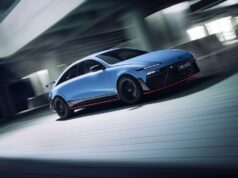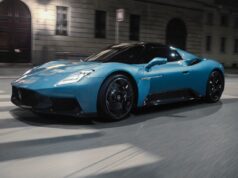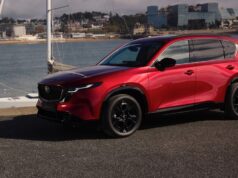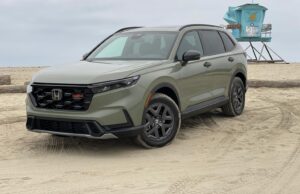2013 is a big year for Hyundai’s crossover lineup, with the release of the all-new 2013 Hyundai Santa Fe.

2013 is a big year for Hyundai’s crossover lineup, with the release of the all-new 2013 Hyundai Santa Fe. This time around the third-generation Hyundai Santa Fe is offered in two versions, the Santa Fe Sport and the longer-wheelbase Santa Fe. How do they stack up? After spending a few days with the Santa Fe Sport in Park City, Utah, one thing is for sure, Hyundai’s all-new Santa fe is quite impressive.

For the 2013 model year, Hyundai decided to kill off the slow selling Veracruz crossover and instead is going to offer two versions of the more popular Santa Fe, the Santa Fe Sport seats up to five passengers, while the Santa Fe with its extended wheelbase, offers three rows of seats for up to seven passengers. It’s a move that makes sense, since most people probably don’t even know what the Veracruz is. For example our cab driver in Utah was excited to hear that Hyundai is releasing a new Santa Fe, but also didn’t even know what the Veracruz was.
How Does it Look?
On the outside the 2013 Santa Fe features Hyundai ‘s “Fluidic Sculpture” design language that is used by Hyundai’s other models like the new Azera, but on the Santa Fe, the styling invokes the impression of motion through a new design concept called Storm Edge, which captures the strong and dynamic images created by nature during the formation of a storm. To create the illusion of constant motion, Hyundai designers gave the Santa Fe a three-bar hexagonal front grille, LED headlight accents, low stance, rising beltline, roof spoiler and wraparound taillights.
Hyundai designers crafted both Santa Fe models together, with the signature differentiating element being the side window shape – the longer Santa Fe features a shape that highlights the increased passenger and cargo room behind the second row seat. From the A-pillar forward, but Santa Fe models are nearly identical with only a few changes, like the grille. As you move back past the A-pillar the differences become apparent. The three-row Santa Fe has its own bodyside character lines from the B-pillar back, grille design, 18-inch alloy wheels and dual exhaust tips.
What’s the Interior Like?
On the inside, both Santa Fe models feature the same overall look and feel. Some of the highlights are the heated rear seats, the standard 40:20:40 folding rear seat back, the available panoramic sunroof and push button start system. If you choose the Santa Fe with cloth seats, the seats feature a YES Essentials seat fabric treatment that provides soil-resistant, anti-odor and anti-static properties for added longevity and livability. A heated steering wheel is also optional.
The three-row Santa Fe increases second-row legroom by 1.9 inches and cargo capacity 5.6 cubic feet. Buyers can choose between second row captain chairs or a full bench seat. The 50:50 split folding third-row bench seat offers 31.5 inches of legroom.
What’s It Got Under the Hood?
If you choose the smaller Santa Fe Sport you can choose between the base 190-hp 2.4-liter four-cylinder engine or a 264-hp turbocharged 2.0-liter GDI engine, both of which are borrowed from the Sonata. Both engines are mated to a six-speed automatic transmission and have the ability to tow up to 3,500 pounds. The front-wheel-drive Santa Fe Sport 2.4 is rated at 22 city and 33 highway, while the Santa Fe Sport 2.0T is rated at 21 city and 31 highway. The all-wheel-drive versions are rated at 21/28 for the 2.4L and 20/27 for the 2.0L turbocharged engine.
The long-wheelbase Santa Fe is only offered with one engine, Hyundai’s 3.3-liter GDI V6 engine, which is also found in the Hyundai Azera. In the Santa Fe the 3.3L V6 puts out 290 horsepower and 252 lb-ft. of torque. The V6 is mated to a standard six-speed automatic and the front-wheel-drive version is rated at 19 mpg city and 26 mpg on the highway.
Buyers can choose from standard front-wheel-drive or the optional Active Cornering Control All-Wheel-Drive system that controls engine torque and braking in conjunction with the Vehicle Stability Management System. According to Hyundai this system can anticipate traction requirements and deliver additional stability through braking via continuous monitoring of driving conditions compared with other AWD systems that can only react to conditions after they occur. The AWD system features a control unit that continuously analyzes data from the vehicle controller, and through a multi-clutch plate distributes torque to any single wheel at a time.
How Does it Drive?
Although there are two versions of the 2013 Santa Fe, Hyundai only gave us a chance to drive the Santa Fe Sport in Utah. The long-wheelbase Santa Fe is not going on sale until early next year.
Most of our time was spent with the five-passenger Santa Fe Sport 2.0T with all-wheel-drive. Most automakers would probably not hold a press introduction for a new model at an elevation of 8,000 feet because of the possible negative impacts on the vehicle’s powertrain (lack of oxygen), but Hyundai was confident that the Santa Fe would be up to the task. It definitely was. The all-new Santa Fe Sport was a joy to drive on the twisty mountain roads. It’s steering and overall suspension are far improved over the last Santa Fe. The 2.0L turbocharged engine packed more than enough power to keep the Santa Fe moving and the best part was that even with all the “pedal to the floor” driving we were doing, we still managed to average 25 MPG.
The Santa Fe also features Hyundai’s new Driver Selectable Steering Mode (DSSM), with three operating modes – Comfort, Normal and Sport. We kept it in “sport” mode for most of the drive, but the differences between the three modes is very small.
Would We Buy One?
The 2013 Santa Fe Sport starts at $24,450, while the Santa Fe Sport 2.0T starts at $27,700. With its new more aggressive styling and available turbocharged engine the new Santa Fe should be on every crossover shopper’s “must test drive” list. Based on how well the five-passenger Santa Fe Sport performed at over 8,000 feet above sea level, we have can’t wait to get behind the wheel of the larger Santa Fe.













